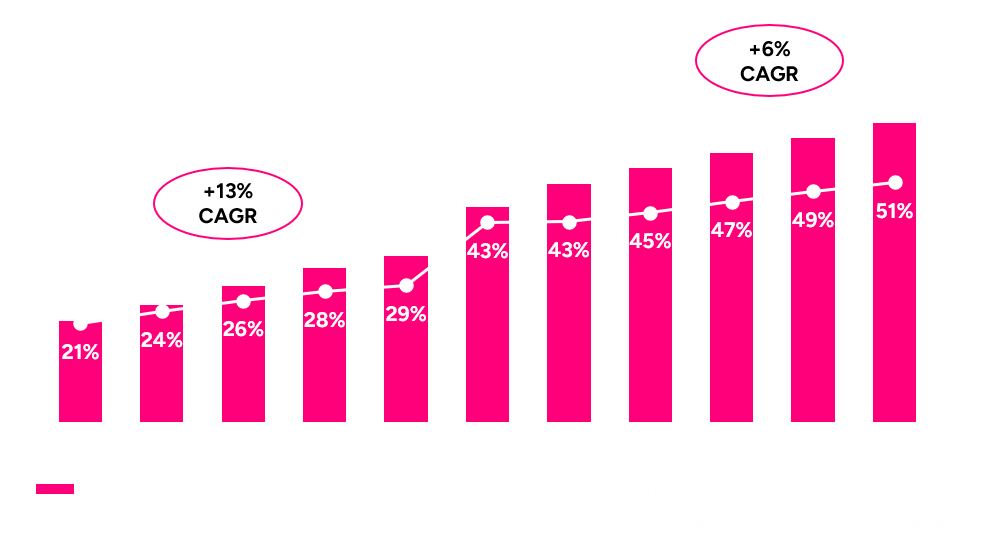There’s Still Opportunity in the UK’s Growing Online Apparel Market
UK consumers have embraced the opportunity to purchase online like no other nation in Europe. Almost 45% of all clothing and footwear retail sales in 2022, amounting to over £27 billion, were completed through electronic means. We also predict the value of online apparel sales to increase by over £1.5 billion each year to 2025.
UK Online Apparel Retail Sales as a Percentage of Total Apparel Sales – 2015 To 2025f

This is a real testament to British shoppers’ determination to enjoy the convenience of online clothes shopping during what continues to be a time of generally dented consumer confidence. News and social media channels are awash with the prospect of rising energy prices, periodic scarcity and rising costs of food and other essential consumer products. Yet, consumer appetite for purchasing apparel online continues apace. Many forward-thinking companies have succeeded in realising that E-Commerce opportunity, with many having taken that first leap into that digital opportunity during the periods of COVID restrictions in 2020 and 2021.
Perhaps, even more remarkable is the large universe of clothing retailers and apparel manufacturers that have managed to survive thus far, without having explored that digital opportunity. Many of those continue to endure economic headwinds, with brick-and-mortar reliant retailers facing the stark reality of a declining revenue pool and limited retail channels in which to compete and satisfy consumers’ changing demands. Sale of clothing and footwear through brick-and-mortar outlets, across the UK, actually declined by £1.5 billion in 2022, as consumers upped their commitment to digital outlets.
So why are so many brick-and-mortar clothing retailers sticking to that one format?
Market Challenges for Clothes and Footwear Retailers and Manufacturers Heading Through 2023
In late 2021, the BOF-McKinsey State of Fashion 2022 Survey recorded that 32% of respondents operating in the fashion sectors cited digital transformation as both the greatest opportunity, but also one of the biggest challenges. As natural advocates of digital transformation, we at Panamoure broadly agree with that finding. The apparel sectors contribute £60 billion-plus to the UK economy each year but the 18,000+ companies it comprises have been some of the most severely impacted in recent years. War in Ukraine, disrupted supply chains, pandemic lockdowns, financial and economic crisis, one after the other have all contributed in the last few years to make the UK an increasingly difficult prospect for many businesses delivering clothing and footwear merchandise to UK consumers. In trying to just keep afloat, many smaller companies feel they don’t have the capacity to consider digital solutions to improve poor operations and difficulties in retaining existing and attracting new customers. In fact, in our experience, it can be perfectly manageable and a digital approach, if pursued sufficiently early, can have far reaching and positive consequences in terms of driving sales and improving overall operational efficiency.
Much of our own work in this sector has been with apparel manufacturers that have taken the leap to sell direct to their end-consumers through the introduction of E-Commerce platforms for the first time. Some fashion retailers also recognised the opportunity to benefit from the disruption caused by COVID restrictions. UK consumers’ abiding desire to purchase fitted well with those retailers that were sufficiently nimble in establishing or enhancing digital retail and customer engagement platforms. Some also took opportunity to acquire other retailers that failed to realise such opportunities themselves. For those producers, distributors and retailers that took those first steps into digital or enhanced what they already had in place during pandemic lockdowns, it really has been a time of opportunity.
The rate of business insolvencies for these apparel segments highlights just what a challenging time it is for the industry. The latest data from The Insolvency Service indicates a relatively benign Q3 for 2022 for companies operating across the clothing and footwear value chain. Yet the first two quarters of 2022 were witness to the highest level of insolvencies for the sectors since the last peak recorded in early 2019. We fully expect the full number of insolvencies in these sectors will exceed 330 companies for 2022.
Insolvencies of UK Clothing Manufacturers, Distributors and Retailers – 2018 To Q3 2022

Whatever the number of insolvencies for the last quarter of 2022 and for the rest of 2023, there’s no escaping the fact that UK operators are struggling to contend with rising materials and energy prices, wages and pensions costs, business rates and regulatory compliance. Its little wonder that many businesses still struggle to consider the growing number of digital solutions available to help companies compete more effectively, attract new and retain existing customers.
We don’t pretend that a transformative digital strategy will always be the perfect solution to growth and continuity, but we do believe that a digital approach offers the best chance for clothing manufacturers and retailers to continue as a going concern in this challenging market. If combined with the right overall business strategy, it will help deliver ambitious growth plans. If that growth is not realised, being in possession of a digital-first model, may yet help secure the right sort of capital investment and valuation from external investors to realise those ambitions and even save what might otherwise be a failing business.
In the next post, we’ll introduce you to how Panamoure delivers that sort of digital transformation to our apparel manufacturers and retail clients.





